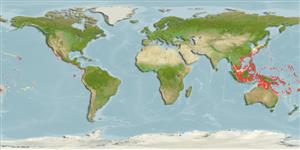Environment: milieu / climate zone / depth range / distribution range
Ecología
marino asociado a arrecife; rango de profundidad 3 - 55 m (Ref. 90102). Subtropical
Indo-West Pacific.
Tamaño / Peso / Age
Maturity: Lm ? range ? - ? cm
Max length : 70.0 cm TL macho / no sexado; (Ref. 90102)
Vértebra: 124 - 132.
Found in coral and rocky reefs, sometimes in silty conditions, in 3-55 m (Ref 90102). Feeds on fishes (Ref. 89972). Nocturnal (Ref. 128523).
Life cycle and mating behavior
Maturities | Reproducción | Spawnings | Egg(s) | Fecundities | Larva
Chen, H.-M., K.-T. Shao and C.T. Chen, 1994. A review of the muraenid eels (Family Muraenidae) from Taiwan with descriptions of twelve new records. Zool. Stud. 33(1):44-64. (Ref. 6934)
IUCN Red List Status (Ref. 130435)
Threat to humans
Harmless
Human uses
Pesquerías: sin interés
Herramientas
Special reports
Download XML
Fuentes de Internet
Estimates based on models
Preferred temperature (Ref.
123201): 24.2 - 29, mean 28 °C (based on 876 cells).
Phylogenetic diversity index (Ref.
82804): PD
50 = 0.5000 [Uniqueness, from 0.5 = low to 2.0 = high].
Bayesian length-weight: a=0.00042 (0.00026 - 0.00067), b=3.30 (3.17 - 3.43), in cm total length, based on LWR estimates for this species & Genus-body shape (Ref.
93245).
Nivel trófico (Ref.
69278): 4.0 ±0.6 se; based on size and trophs of closest relatives
Resiliencia (Ref.
120179): Medio, población duplicada en un tiempo mínimo de 1.4-4.4 años (Preliminary K or Fecundity.).
Fishing Vulnerability (Ref.
59153): Moderate to high vulnerability (48 of 100).
